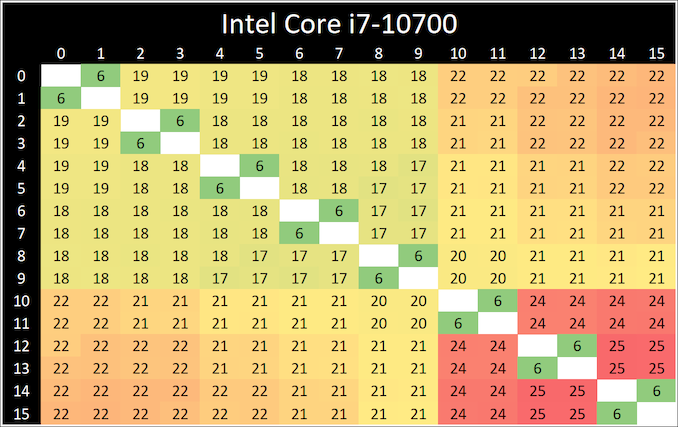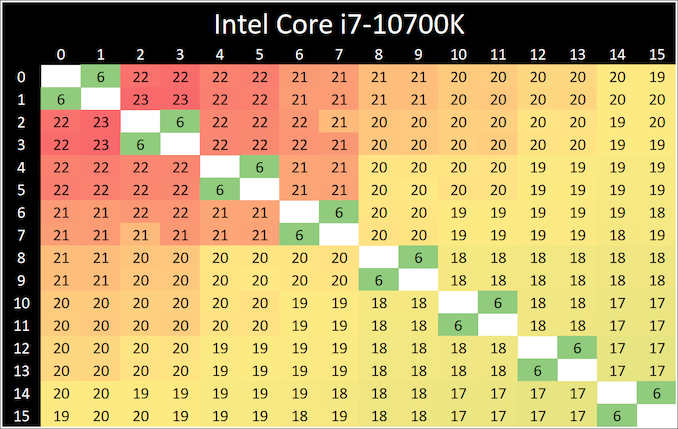Intel Core i7-10700 vs Core i7-10700K Review: Is 65W Comet Lake an Option?
by Dr. Ian Cutress on January 21, 2021 10:30 AM EST- Posted in
- CPUs
- Intel
- Core i7
- Z490
- 10th Gen Core
- Comet Lake
- i7-10700K
- i7-10700
CPU Tests: Microbenchmarks
Core-to-Core Latency
As the core count of modern CPUs is growing, we are reaching a time when the time to access each core from a different core is no longer a constant. Even before the advent of heterogeneous SoC designs, processors built on large rings or meshes can have different latencies to access the nearest core compared to the furthest core. This rings true especially in multi-socket server environments.
But modern CPUs, even desktop and consumer CPUs, can have variable access latency to get to another core. For example, in the first generation Threadripper CPUs, we had four chips on the package, each with 8 threads, and each with a different core-to-core latency depending on if it was on-die or off-die. This gets more complex with products like Lakefield, which has two different communication buses depending on which core is talking to which.
If you are a regular reader of AnandTech’s CPU reviews, you will recognize our Core-to-Core latency test. It’s a great way to show exactly how groups of cores are laid out on the silicon. This is a custom in-house test built by Andrei, and we know there are competing tests out there, but we feel ours is the most accurate to how quick an access between two cores can happen.
When we first reviewed the 10-core Comet Lake processors, we noticed that a core (or two) seemed to take slightly longer to ping/pong than the others. These two parts are both derived from the 10-core silicon but with two cores disabled, and we still see a pattern of some cores having additional latency. The ring on the 8-core parts still acts like a 10-core ring, but it all depends on which cores were disabled.
Frequency Ramping
Both AMD and Intel over the past few years have introduced features to their processors that speed up the time from when a CPU moves from idle into a high powered state. The effect of this means that users can get peak performance quicker, but the biggest knock-on effect for this is with battery life in mobile devices, especially if a system can turbo up quick and turbo down quick, ensuring that it stays in the lowest and most efficient power state for as long as possible.
Intel’s technology is called SpeedShift, although SpeedShift was not enabled until Skylake.
One of the issues though with this technology is that sometimes the adjustments in frequency can be so fast, software cannot detect them. If the frequency is changing on the order of microseconds, but your software is only probing frequency in milliseconds (or seconds), then quick changes will be missed. Not only that, as an observer probing the frequency, you could be affecting the actual turbo performance. When the CPU is changing frequency, it essentially has to pause all compute while it aligns the frequency rate of the whole core.
We wrote an extensive review analysis piece on this, called ‘Reaching for Turbo: Aligning Perception with AMD’s Frequency Metrics’, due to an issue where users were not observing the peak turbo speeds for AMD’s processors.
We got around the issue by making the frequency probing the workload causing the turbo. The software is able to detect frequency adjustments on a microsecond scale, so we can see how well a system can get to those boost frequencies. Our Frequency Ramp tool has already been in use in a number of reviews.
Both processors ramp from idle to full turbo in about six milliseconds, well within a single frame of standard gaming.













210 Comments
View All Comments
Spunjji - Friday, January 22, 2021 - link
Who's to decide which memory speeds they ought to test with, though? They can't rightly test with all of them, but what's "enough" - 3200, 3600, 4000?The honest truth is you can get info about performance of a specific CPU with varying memory speeds elsewhere. For the few percent difference in performance it actually makes, I personally don't care whether or not they bother, and I've been coming here for well over 15 years now.
Oxford Guy - Friday, January 22, 2021 - link
Who decides? The reviewer. Reviewers are supposed to know where the sweet spot is. It’s not that difficult to figure out.Oxford Guy - Friday, January 22, 2021 - link
It’s also hilarious for Intel to allegedly be worried about ‘RAM’ overclocking but not pushing ‘65W’ CPUs to 215W sustained.I’ll buy that for a dollar!
Spunjji - Monday, January 25, 2021 - link
On this point, we agree. Intel's definition of what does and does not constitute overclocking has become increasingly bizarre.IanCutress - Saturday, January 23, 2021 - link
What? No. A reviewers job is to provide consistent and trackable data that holds the vendor to their claims. What you're looking for is a buyers guide.Oxford Guy - Sunday, January 24, 2021 - link
The data comes from assembling the correct components.Qasar - Sunday, January 24, 2021 - link
which, as Dr Cutress said, is called a buyers guide. this is a review.Oxford Guy - Monday, January 25, 2021 - link
Oh please. A review tells people how the equipment performs. Since Zen 2, for instance, is most efficient at 3600 RAM speed, running it at JEDEC, a standard designed so that el-cheapo boards can support it, is not a good one. It does not tell readers how the equipment maximally performs.Qasar - Tuesday, January 26, 2021 - link
Product reviews show customer experience with a product or brand. It’s where customers give their opinion on what they think about your product, and this can be positive or negative. Positive reviews show the customer was satisfied with the quality of the product, while negative reviews indicate bad experiences.Buying guides, on the other hand, help customers identify the right product to buy. A buyer’s guide includes a product’s specifications, how it compares with other similar products, the benefits, and such. Buying guides provide readers with the necessary information needed to make informed purchasing decisions.
Spunjji - Monday, January 25, 2021 - link
What if I don't agree about the location of the "sweet spot" based on RAM prices local to me, or my own performance needs? Your response isn't the best solution to the problem, it's just a different answer.My preference is for the reviewer to test a CPU at-or-near stock settings, then publish separate articles on things like the returns on faster RAM speeds/timings and overclocking. The minor performance difference from faster RAM really isn't enough to invalidate the review's conclusions.